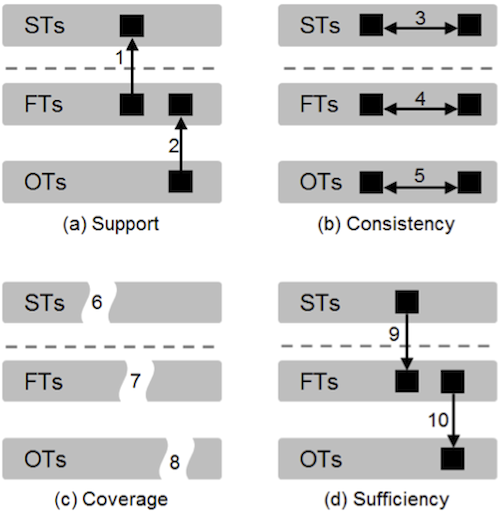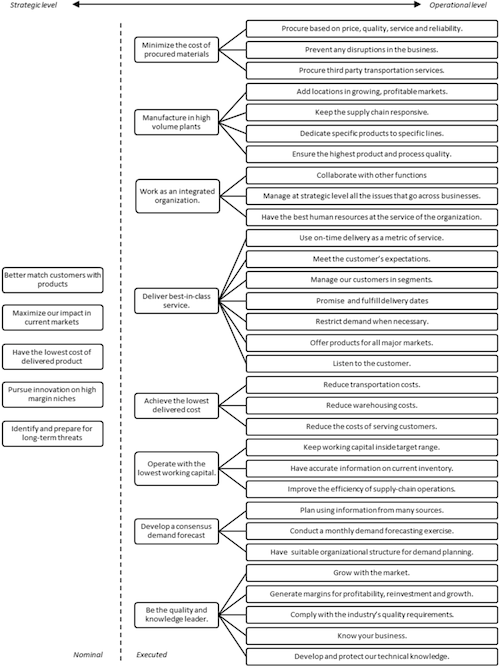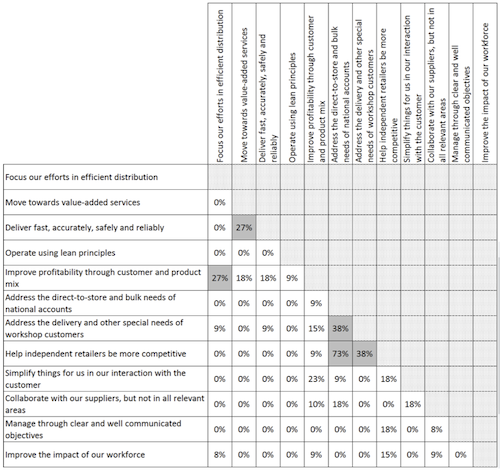Evaluation of a Firm's Supply Chain Strategy
Today’s paper is brand new and based on the dissertation works of Roberto Perez-Franco. It can be considered as a summary of the current state of the art in supply chain strategy and extends knowledge in the field of strategy evaluation. It can be downloaded for example from Yossi Sheffi’s homepage at the MIT.
Foundation
The authors founded the following findings on two action research project with Saflex and a health care company. Several dozen interviews were conducted on different levels within the companies.
For the further research the authors define the major terms used: supply chain strategy and the difference between the supply chain and the supply chain strategy:
For the purpose of this paper, the supply chain strategy of a firm is understood as the set of ideas behind the activities, decisions and choices of that firm‟s supply chain, which serve as logical bridge between the supply chain operations in the field and the business strategy.
The difference between a supply chain and a supply chain strategy is the difference between a set of physical entities and a set of ideas. So, for example, when AMR Research publishes its “Supply Chain Top 25” list, what they are ranking are supply chains, not supply chain strategies.
Functional Strategy Map (FSM)
The authors introduce a Functional Strategy Map which “is a conceptual representation of the supply chain strategy as a bridge between operations and business strategy”. Three layers are aggregated in the FSM: strategic, functional and operational (figure 1).

A company’s supply chain is then evaluated based on the this concept using the criteria mentioned below.
A example of the FSM might look like that from Saflex in figure 2.
Evaluation criteria
The evaluation criteria were agreed upon before the first action research, but were adapted due to the new findings from the first and second action research.
The final suggested criteria are:
- “Support: activities should support the goals of the supply chain strategy”
- “Consistency: components of the supply chain strategy should be compatible”
- “Coverage: the supply chain strategy should address all important areas”
- “Sufficiency: the goals should be fully satisfied by the supply chain strategy”
Figure 3 illustrates the criteria.

(1) Functional support: the functional themes are expected to support the strategic themes. (3) Strategic consistency: the strategic themes are expected to be compatible among themselves. (7) Functional coverage: the functional themes are expected to address all the areas of interest to the functions. (10) Functional sufficiency: The functional themes should be satisfied by the operational themes.
The authors also defined methods to evaluate these criteria within a company. I highlight the results of the consistency check here and refer you to the full paper if you are interested in more about the methods used here.
Figure 4 shows the incompatibility matrix for the second company. Each axis contains the functional goals of the company and the percentages indicate the incompatibility between the ideas as given by the interviewees (lower means more compatible).
Thus this graph gives an good overview of strategic incompatibilities and clashes.
Conclusion
Thats already it. Of course the other criteria have to be evaluated as well and the authors have several of their questionnaires in the appendix.
The topic indeed is cutting edge, since there is not yet any literature on supply chain strategy evaluation.
Maybe the authors also already gave the reason for this lack of literature: Several studies already found that only less than 50% of the companies actually have a supply chain strategy.
But using this concept and these methods is a great way to make the supply chain strategy explicit and documented and evaluate it in the process as well!
Perez-Franco, R., Singh, M., & Sheffi, Y. (2011). An approach to evaluate a firm’s supply chain strategy as a conceptual system International Journal of Production Economics










Add new comment